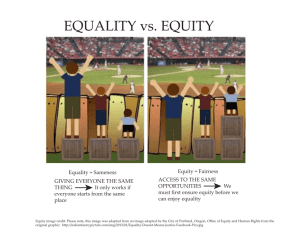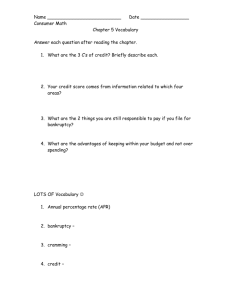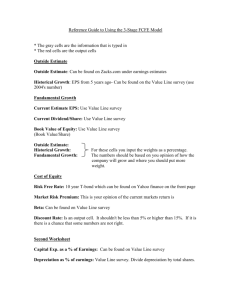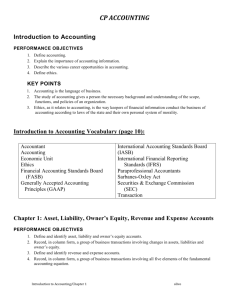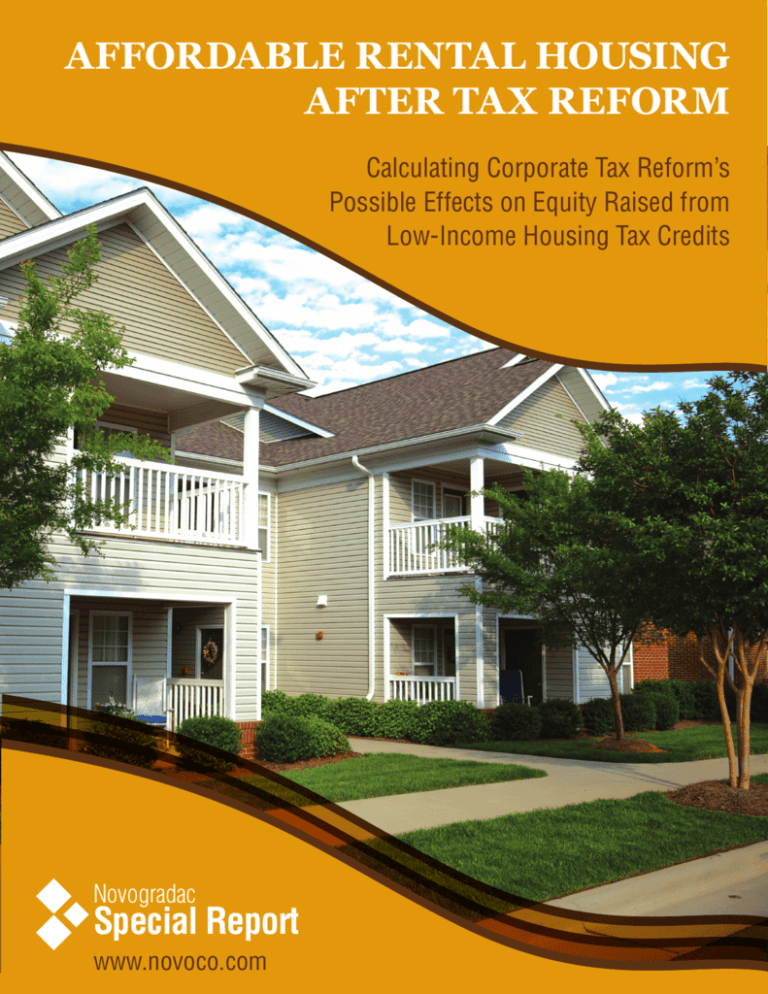
AFFORDABLE RENTAL HOUSING
AFTER TAX REFORM
Calculating Corporate Tax Reform’s
Possible Effects on Equity Raised from
Low-Income Housing Tax Credits
Novogradac
Special Report
www.novoco.com
AFFORDABLE RENTAL HOUSING
AFTER TAX REFORM
Calculating Corporate Tax Reform’s
Possible Effects on Equity Raised from
Low-Income Housing Tax Credits
By Novogradac & Company LLP
Affordable Rental Housing After Tax Reform
2
This publication is designed to provide accurate and authoritative information in regard to the
subject matter covered. In purchasing or using this report, the purchaser and/or user of the report
agrees that the author, contributing authors and publisher are not engaged in or providing any
legal, accounting or other professional services through the publication and dissemination of this
report or its contents. Any information obtained from this report may change from time to time
without notice. For this reason, the user of this report should check all materials to their original
source documents and update the information before using any information contained herein.
©2013 Novogradac & Company LLP. All Rights Reserved.
ISBN #978-0-9837715-4-8
Affordable Rental Housing After Tax Reform
3
Contents
Contents
Introduction5
Analysis6
Effect on Yields of Lower Marginal Corporate Tax Rates 9
On Yields
9 Percent LIHTC Investments
4 Percent Tax-Exempt Bond Investments
On Investor Equity Pricing
9 Percent LIHTC Investments
4 Percent Tax-Exempt Bond Investments
On Equity Raised 9 Percent LIHTC Investments
4 Percent Tax-Exempt Bond Investments
9
10
11
12
13
14
Effect on Yields of Longer Depreciation Periods, Added to Lower Marginal
Corporate Tax Rates 15
On Yields
9 Percent LIHTC Investments 15
4 Percent Tax-Exempt Bond Investments
16
On Investor Equity Pricing
9 Percent LIHTC Investments
17
4 Percent Tax-Exempt Bond Investments
18
On Equity Raised
9 Percent LIHTC Investments
19
4 Percent Tax-Exempt Bond Investments
20
Total20
Conclusion 21
About Novogradac & Company LLP
22
On the cover:
Photo: Courtesy of DHIC Inc.
Highland Village Apartments features 50 one-, two- and three-bedroom units affordable for households earning below 60 percent of the area
median income in Cary, N.C.
Affordable Rental Housing After Tax Reform
4
Introduction
Introduction
If current efforts to enact corporate tax reform are successful, the resulting changes to the tax
code will affect the amount of equity that can be raised from the low-income housing tax credit
(LIHTC). These effects could be positive or negative, depending on the totality of the impact of the
various changes. The most obvious and direct impact on equity that can be raised from the LIHTC
would be changes in the authorized annual amount of LIHTCs.1 If an increase in annual LIHTCs
were authorized, consistent with recommendations of the Bipartisan Policy Center,2 then such a
change would have a positive impact on equity raised. Conversely, a reduction of annual LIHTC
authority would directly reduce the amount of equity raised for affordable rental housing.
Even if the LIHTC itself emerges from tax reform unchanged, other possible changes to the tax
code would affect the amount of LIHTC equity that can be raised.
One of the basic tenets of tax reform is to broaden the base and lower the marginal tax rate.3 House
Republicans have targeted a lower top corporate tax rate of 25 percent.4 President Barack Obama
has suggested a top tax rate of 28 percent for most corporations, and 25 percent for manufacturing
firms.5 On the base broadening front, extending depreciation periods is one of many measures
that has been raised in public discussions. This proposal6 often involves moving to an alternative
depreciation system (ADS), under which property is depreciated over longer periods than under
the current system and which would lengthen the depreciation period for residential real estate
to 40 years.
As such, it’s worth considering the possible ripple effects of these two tax reform outcomes on
LIHTC investor yields, investor equity pricing and the amount of equity raised.
To gauge the effect of lower corporate tax rates and longer depreciation periods on LIHTC yields
and investor equity pricing, Novogradac & Company ran a series of calculations using an investor
internal rate of return (IRR) model, at a range of investor equity prices from $0.80 to $1.00, for
9 percent investments and 4 percent tax-exempt bond investments. The calculations considered
the effect of the corporate tax rate dropping from the current level of 35 percent to 30 percent, 28
1 Annual LIHTC caps can be found at www.novoco.com/low_income_housing/lihtc/federal_lihtc.php.
2 “Housing America’s Future: New Directions for National Policy,” Economic Policy Program Housing Commission, February
2013.
3 “Tax Credits: The Key to Tax Reform?,” Michael J. Novogradac, CPA, Novogradac Journal of Tax Credits, September 2012.
4 “International Tax Reform Discussion Draft,” Ways and Means Committee Republicans, October 26, 2011.
5 “The President’s Framework for Business Tax Reform,” The White House and the Department of the Treasury, February 2012.
6 “Business Investment and Innovation,” Senate Finance Committee Staff Tax Reform Options for Discussion, April 11, 2013.
Affordable Rental Housing After Tax Reform
5
Analysis
percent and 25 percent. We also ran calculations to estimate the effect of extending the depreciation
period for residential rental property from 27.5 years to 40 years, the depreciation period for land
improvements from 15 to 20 years and the depreciation period for personal property from five to
nine years.
This evaluation found that if the amount of investor equity is held constant, lower top corporate
tax rates lead to lower LIHTC yields, creating downward pressure on LIHTC investor equity
pricing. Layering in the effect of extending depreciation periods would further exacerbate these
reductions. For the equity market as a whole, this could mean a loss of $220 million to nearly $1
billion dollars, or more, in equity used to finance affordable rental housing. This represents a drop
in equity raised of between 2.7 percent and 13 percent, or more.
Analysis
The analysis presented in this report illustrates the range of possible outcomes and estimates the
impact on investor equity pricing and investor yields at three lower corporate tax rates as well as
two depreciation periods.
For modeling purposes, we created an illustrative 9 percent tax credit transaction and illustrative
4 percent tax-exempt bond tax credit transaction.7 Our results assume a conservative investor
equity price range of $0.80 to $1.00, and the scenarios we considered didn’t vary for factors that
commonly affect investor demand and investor equity pricing, such as property type, transaction
terms or Community Reinvestment Act considerations.8
For each illustrative transaction, we began with initial baseline assumptions regarding revenue,
expenses, debt and LIHTCs. Key assumptions include setting rental and operating escalators at 2
percent and 3 percent, respectively. Vacancy rates were established at 5 percent and the required
debt coverage ratio was assumed to be 1.15. For 4 percent tax-exempt bond transactions, tax credit
percentages were fixed at 3.19 percent, and for 9 percent tax credit transactions, credit percentages
were fixed at 9 percent. The illustrative example assumes a 100 percent low-income housing
percentage and that the partnership receives the tax credits over a 10-year tax credit period. The
7 For an in-depth look at the technical aspects of the LIHTC, see Novogradac & Company LLP Low-Income Housing Tax Credit
Handbook, 2012.
8 For a discussion of the LIHTC equity market and factors affecting demand and investor equity pricing, see “Competing Interests,
Falling Yields Create Conflict,” Jennifer Dockery, Novogradac Journal of Tax Credits, August 2012.
Affordable Rental Housing After Tax Reform
6
Analysis
illustrative example is assumed to not be in a difficult to develop area (DDA).9 In addition, the
illustrative transactions assume a 99.99 percent limited partner interest and an investor exit after
the 15-year tax credit compliance period. Our model also makes the conservative assumption that
the limited partner does not receive any cash distributions.
Our illustrative examples included tax credit investor equity pricing at $0.80, $0.90, and $1.00.
The differences in the amount of equity financing in each illustrative example is balanced with an
increase or decrease in permanent financing while maintaining a debt to coverage ratio of 1.15.
The two depreciation scenarios in our analysis for both types of financing transactions measure the
impact of a change in depreciable life of acquired and rehabilitated rental property, improvements
and personal property. The first scenario calculates the recovery periods as 27.5 year residential
property, 15 year land improvements and five year personal property. The depreciable basis
allocations in our sample model were 95 percent building, 3 percent land improvements, and 2
percent personal property.10 The second scenario uses the following respective recovery periods
for such property: 40 years, 20 years and nine years.
9 Internal Revenue Code Section 42(d)(5) allows eligible basis for LIHTC developments in DDAs or qualified census tracts (QCTs)
to be increased up to 130 percent.
10 Personal property consists of furniture, fixtures and equipment. Land improvements include such costs as access roads, fences
and paving.
Photo: Courtesy of Tuscaloosa Housing Authority
Rosedale Court in Tuscaloosa, Ala. was rehabilitated after a tornado and subsequent storms devastated much of Alabama in April 2011.
Affordable Rental Housing After Tax Reform
7
Analysis
The first step of our analysis was to calculate the isolated effect of lower corporate tax rates ranging
from 30 percent to 25 percent. We began by estimating the reduction in investor yields, assuming
investors were willing to invest the same amount of capital. Next, we estimated the reduction in
the investor equity price, assuming the investor sought to maintain its pre-tax reform yield. Then
we estimated what the reduction in investor equity pricing would mean in aggregate equity raised
in the 9 percent and 4 percent LIHTC markets.
Our analysis then layered in the additional impact of longer depreciation lives, first with reduction
in yield, then with reduction in investor equity price, and again, with possible reductions in
aggregate tax credit equity.
Affordable Rental Housing After Tax Reform
8
Effect on Yields of Lower Marginal
Corporate Tax Rates
As a starting point, we calculated the effect of lower corporate tax rates on investor yields,
assuming investors were willing to invest the same amount of capital.
9 Percent LIHTC Investments
If investor equity pricing remained the same after tax reform as it was before, our analysis found
that a drop in the top tax rate from 35 percent to 30 percent could reduce yields for a 9 percent
volume cap new construction investment by 54 to 61 basis points, or more. Lowering the top tax
rate to 28 percent could reduce yields for a 9 percent volume cap new construction investment by
76 to 87 basis points, or more. And at the lowest end of the range, a top tax rate of 25 percent could
reduce yields for a 9 percent volume cap new construction investment by 110 to 126 basis points,
or more.
Estimated Yield Changes for a 9% Volume Cap New Construction Investment
Decrease in Basis Points
for Drop in Top Tax Rate
Investor Equity Price
$0.80
$0.90
$1.00
From 35% to 30%
54
58
61
From 35% to 28%
76
81
87
From 35% to 25%
110
118
126
Because the 9 percent LIHTC market represents only part of the picture, we then considered the
effect of lower corporate tax rates on investor yields for 4 percent tax-exempt bond investments
and found they were slightly more significant than the effects for 9 percent investments.
Affordable Rental Housing After Tax Reform
9
Effect on Yields of Lower Marginal Corporate Tax Rates
4 Percent Tax-Exempt Bond Investments
If investor equity pricing remained the same, we found that a drop in the top tax rate from 35
percent to 30 percent could reduce yields for a 4 percent tax-exempt bond investment by 60 to 65
basis points, or more. Lowering the top tax rate to 28 percent could reduce yields for a 4 percent
tax-exempt bond investment by 84 to 91 basis points, or more. And at the lowest end of the range,
a top tax rate of 25 percent could reduce yields for a 4 percent tax-exempt bond investment by 121
to 132 basis points, or more.
Estimated Yield Changes for a 4% Tax-Exempt Bond Investment
Decrease in Basis Points
for Drop in Top Tax Rate
Investor Equity Price
$0.80
$0.90
$1.00
From 35% to 30%
60
62
65
From 35% to 28%
84
88
91
From 35% to 25%
121
126
132
As noted, these figures are based on the assumption that LIHTC investor equity price remained
unchanged. However, if instead investors were seeking the same yields after tax reform as they
did before, the result would be downward pressure on investor equity pricing as illustrated in the
next step of our analysis.
Photo: Courtesy of Marian Development Group LLC
The Stoddard-Johnston Scholar House in Louisville, Ky. provides apartments for single parents who are pursuing college degrees.
Affordable Rental Housing After Tax Reform
10
Effect on Investor Equity Pricing of
Lower Marginal Corporate Tax Rates
Assuming investors sought the same yields for affordable rental housing investments after tax
reform as they did before, our estimates show there would be downward pressure on tax credit
investor equity pricing.
9 Percent LIHTC Investments
For a 9 percent volume cap new construction investment, assuming investors need to achieve
the same yields after tax reform as they did before, our findings show that a drop in the top tax
rate from 35 percent to 30 percent could reduce LIHTC investor equity prices between 2 and 4
cents, or more. A reduction in the top tax rate from 35 percent to 28 percent could reduce LIHTC
investor equity prices between 3 and 5 cents, or more. And a reduction in the top tax rate from
35 percent to 25 percent -- the lowest rate we considered -- could reduce LIHTC investor equity
prices for a 9 percent volume cap new construction investment between 4 and 8 cents, or more.
Estimated Investor Equity Pricing Changes for a 9% Volume Cap New Construction Investment
Cost per Dollar Decrease
for Drop in Top Tax Rate
Investor Equity Price
$0.80
$0.90
$1.00
From 35% to 30%
$0.023
$0.032
$0.041
From 35% to 28%
$0.033
$0.045
$0.058
From 35% to 25%
$0.048
$0.065
$0.085
Similar to the effect that lower corporate tax rates had on yields for 9 percent transactions and
tax-exempt bond investments, our analysis found that investor equity pricing decreases were
slightly larger under lower top tax rates for 4 percent tax-exempt bond transactions than for 9
percent volume cap investments.
Affordable Rental Housing After Tax Reform
11
Effect on Investor Equity Pricing of Lower Marginal Corporate Tax Rates
4 Percent Tax-Exempt Bond Investments
For a 4 percent tax-exempt bond investment, assuming investors need to achieve the same yields
after tax reform as they did before, our findings show that a drop in the top tax rate from 35
percent to 30 percent could reduce LIHTC investor equity prices between 2 and 4 cents, or more.
A reduction in the top tax rate from 35 percent to 28 percent could reduce investor equity prices
between 3 and 5 cents, or more. And a reduction in the top tax rate from 35 percent to 25 percent
-- the lowest rate we considered -- could reduce LIHTC investor equity prices for a 4 percent taxexempt bond investment between 5 and 8 cents, or more.
Estimated Investor Equity Pricing Changes for a 4% Tax-Exempt Bond Investment
Cost per Dollar Decrease
for Drop in Top Tax Rate
Investor Equity Price
$0.80
$0.90
$1.00
From 35% to 30%
$0.025
$0.033
$0.042
From 35% to 28%
$0.035
$0.046
$0.059
From 35% to 25%
$0.050
$0.066
$0.086
The next logical question then becomes, based on these projected investor equity pricing
reductions, what would the effect of these lower corporate tax rates be on the amount of equity
raised for affordable rental housing?
Photo: Courtesy of Carrfour Supportive Housing Inc.
Carrfour Supportive Housing Inc., the developer of Parkview Gardens in Miami, Fla., works closely with the U.S. Department of Veterans Affairs
to provide support and services to the property’s veteran residents.
Affordable Rental Housing After Tax Reform
12
Effect on Equity Raised of Lower
Marginal Corporate Tax Rates
We continued our calculations with the assumption that investors will require the same yields
for affordable rental housing investments after tax reform as they did before to determine the
resulting reduction in equity raised for those investments.
9 Percent LIHTC Investments
In 2013, approximately $7.3 billion in 9 percent LIHTCs will be available.
Based on our calculations, lower corporate tax rates could result in 2.9 percent to 8.5 percent less
equity that could be raised for the creation of affordable rental housing in the 9 percent investment
market. This translates to a reduction in equity raised of $171 to $619 million dollars, or more, for
9 percent LIHTCs alone.
Estimated Change in Equity Raised for 9% Volume Cap New Construction Transactions
Investor Equity Price
$0.80
$0.90
$1.00
Percent Equity Reduction
2.93%
3.52%
4.13%
Reduction in Equity Raised in millions*
$171
$231
$302
Percent Equity Reduction
4.13%
4.96%
5.84%
Reduction in Equity Raised in millions*
$241
$326
$427
Percent Equity Reduction
5.96%
7.19%
8.48%
Reduction in Equity Raised in millions*
$348
$472
$619
Drop in Top Tax Rate from 35% to 30%
Drop in Top Tax Rate from 35% to 28%
Drop in Top Tax Rate from 35% to 25%
* Assuming $7.3 billion in 9% LIHTCs in 2013, rounded to the nearest million
Adding in the effect on equity raised for 4 percent tax-exempt bond transactions raises the stakes.
Affordable Rental Housing After Tax Reform
13
Effect on Equity Raised of Lower Marginal Corporate Tax Rates
4 Percent Tax-Exempt Bond Investments
Based on recent years’ volume, we estimate an annual 4 percent tax-exempt bond market of $2
billion in 4 percent LIHTCs available in 2013.
Our calculations show that lower corporate tax rates could result in 3.1 percent to 8.6 percent
less equity that could be raised for 4 percent tax-exempt bond transactions. This translates to a
reduction in equity raised of $50 to $172 million dollars, or more, for 4 percent LIHTCs.
Estimated Change in Equity Raised for 4% Tax-Exempt Bond Transactions
Investor Equity Price
$0.80
$0.90
$1.00
3.11%
3.63%
4.21%
$50
$65
$84
4.37%
5.12%
5.94%
$70
$92
$119
Percent Equity Reduction
6.30%
7.39%
8.60%
Reduction in Equity Raised in millions*
$101
$133
$172
Drop in Top Tax Rate from 35% to 30%
Percent Equity Reduction
Reduction in Equity Raised in millions*
Drop in Top Tax Rate from 35% to 28%
Percent Equity Reduction
Reduction in Equity Raised in millions*
Drop in Top Tax Rate from 35% to 25%
* Assuming $2 billion in 4% credits in 2013, rounded to the nearest million
When combined, the reductions in equity raised are significant.
Total Estimated Change in Equity Raised - Change in Tax Rate
Reduction in Equity Raised,* in
millions, for Drop in Top Tax Rate
Investor Equity Price
$0.80
$0.90
$1.00
From 35% to 30%
$221
$296
$386
From 35% to 28%
$311
$418
$545
From 35% to 25%
$449
$605
$791
* Assuming $7.3 billion in 9% LIHTCs in 2013, $2 billion in 4% credits in 2013, rounded to the nearest million
As shown above, lower corporate tax rates could result in a reduction of equity raised of $221
million to $791 million, or more, to build, rehabilitate and/or preserve affordable rental housing.
Because it’s possible that in addition to lowering corporate tax rates tax reform could also extend
depreciation lives,11 our next step was to consider the effects of both changes at once.
11 “LIHTC Revenue’s Contribution to Tax Reform,” http://novogradac.wordpress.com/2011/10/12/lihtc-revenue%E2%80%99scontribution-to-tax-reform/, October 12, 2011.
Affordable Rental Housing After Tax Reform
14
Effect on Yields of Longer Depreciation Periods,
Added to Lower Marginal Corporate Tax Rates
To consider the combined effect of lower corporate tax rates and longer depreciation periods on
the LIHTC investment market, we took a step back and again began by examining the effect on
investor yields, assuming investors were willing to invest the same amount of capital.
9 Percent LIHTC Investments
If depreciation periods are extended and the top tax rate decreased from 35 percent to 30 percent
yields for a 9 percent volume cap new construction investment could drop by 88 to 105 basis
points, or more. Lowering the top tax rate to 28 percent and extending depreciation periods could
reduce yields for a 9 percent volume cap new construction investment by 111 to 123 basis points,
or more. And at the lowest end of the range, a top tax rate of 25 percent combined with extended
depreciation periods could reduce yields for a 9 percent volume cap new construction investment
by 146 to 151 basis points, or more.
Estimated Yield Changes for a 9% Volume Cap New Construction Investment
Decrease in Basis Points for Longer
Depreciation Periods and Drop in Top Tax Rate
Investor Equity Price
$0.80
$0.90
$1.00
From 35% to 30%
105
95
88
From 35% to 28%
123
116
111
From 35% to 25%
151
148
146
Applying these same assumptions to 4 percent tax-exempt bond transactions produced a larger
effect.
Affordable Rental Housing After Tax Reform
15
Effect on Yields of Longer Depreciation Periods, Added to Lower Marginal Corporate Tax Rates
4 Percent Tax-Exempt Bond Investments
If depreciation periods are extended and the top tax rate decreased from 35 percent to 30 percent,
yields for a 4 percent tax-exempt bond investment could drop by 137 to 200 basis points, or more.
Lowering the top tax rate to 28 percent and extending depreciation periods could reduce yields
for a 4 percent tax-exempt bond investment by 156 to 215 basis points, or more. And at the lowest
end of the range, a top tax rate of 25 percent combined with extended depreciation periods could
reduce yields for a 4 percent tax-exempt bond investment by 187 to 236 basis points, or more.
Estimated Yield Changes for a 4% Tax-Exempt Bond Investment
Decrease in Basis Points for Longer
Depreciation Periods and Drop in Top Tax Rate
Investor Equity Price
$0.80
$0.90
$1.00
From 35% to 30%
200
164
137
From 35% to 28%
215
181
156
From 35% to 25%
236
208
187
Photo: Courtesy of DHIC Inc.
Highland Terrace, LEED Certified housing for seniors 55 or older, was the final affordable piece of DHIC Inc.’s Highland Village in Cary, N.C.
Affordable Rental Housing After Tax Reform
16
Effect on Investor Equity Pricing of
Longer Depreciation Periods, Added to
Lower Marginal Corporate Tax Rates
Moving on to investor equity pricing, our calculations again show that the affordable housing
could expect lower LIHTC investory equity prices under the tax reform scenarios in question.
9 Percent LIHTC Investments
If depreciation periods are extended and the top tax rate decreased from 35 percent to 30 percent
LIHTC investor equity prices could be reduced between 4 and 5 cents, or more, for 9 percent
volume cap investments. Extended depreciation periods combined with a reduction in the top tax
rate from 35 percent to 28 percent could reduce LIHTC investor equity prices between 5 and 7
cents, or more. And finally, a reduction in the top tax rate from 35 percent to 25 percent combined
with extended depreciation periods could reduce LIHTC investor equity prices for a 9 percent
volume cap new construction investment between 6 and 9 cents, or more.
Estimated Investor Equity Pricing Changes for a 9% Volume Cap New Construction Investment
Cost per Dollar Decrease for Longer
Depreciation Periods and Drop in Top Tax Rate
Investor Equity Price
$0.80
$0.90
$1.00
From 35% to 30%
$0.046
$0.052
$0.059
From 35% to 28%
$0.054
$0.063
$0.075
From 35% to 25%
$0.066
$0.081
$0.098
As with previous scenarios, the effect of extended depreciation periods is more pronounced for a
4 percent tax-exempt bond investment.
Affordable Rental Housing After Tax Reform
17
Effect on Investor Equity Pricing of Longer Depreciation Periods, Added to Lower Marginal Corporate Tax Rates
4 Percent Tax-Exempt Bond Investments
If depreciation periods are extended and the top tax rate decreased from 35 percent to 30 percent
LIHTC investor equity prices for a 4 percent tax-exempt bond transaction could be reduced
between 8 and almost 9 cents, or more. Extended depreciation periods combined with a reduction
in the top tax rate from 35 percent to 28 percent could reduce LIHTC investor equity prices for a
4 percent tax-exempt bond transaction between 8 and 10 cents, or more. And finally, a reduction
in the top tax rate from 35 percent to 25 percent combined with extended depreciation periods
could reduce LIHTC investor equity prices for a 4 percent tax-exempt bond investment between
9 and 12 cents, or more.
Estimated Investor Equity Pricing Changes for a 4% Tax-Exempt Bond Investment
Investor Equity Price
Cost per Dollar Decrease for Longer
Depreciation Periods and Drop in Top Tax Rate
From 35% to 30%
$0.80
$0.90
$1.00
$0.083
$0.086
$0.089
From 35% to 28%
$0.089
$0.095
$0.102
From 35% to 25%
$0.098
$0.109
$0.122
Building on this information, our analysis then calculated the estimated changes in the amount of
equity that could be raised in such scenarios.
Photo: Courtesy of Wasatch Advantage Group
Providence Place Apartments is a 125-unit workforce housing community in downtown Salt Lake City, Utah.
Affordable Rental Housing After Tax Reform
18
Effect on Equity Raised of Longer
Depreciation Periods, Added to Lower
Marginal Corporate Tax Rates
Combining extended depreciation periods with lower tax rates significantly intensifies the effect
on the overall amount of equity that would be raised for affordable rental housing development
and preservation. The effect is also more acute for tax-exempt bond investments, as shown in the
tables below.
9 Percent LIHTC Investments
Based on our calculations, lower corporate tax rates combined with longer depreciation periods
could result in 5.7 to 9.8 percent less equity that could be raised for 9 percent investments. In
dollars, this represents a reduction in equity raised between $333 and $719 million, or more.
Estimated Change in Equity Raised for a 9% Volume Cap New Construction Investment
Investor Equity Price
$0.80
$0.90
$1.00
Percent Equity Reduction
5.71%
5.79%
5.92%
Reduction in Equity Raised in millions*
$333
$380
$432
Percent Equity Reduction
6.70%
7.05%
7.46%
Reduction in Equity Raised in millions*
$392
$463
$544
Percent Equity Reduction
8.24%
9.00%
9.84%
Reduction in Equity Raised in millions*
$481
$591
$719
Top Tax Rate of 30%, Longer Depreciation Period
Top Tax Rate of 28%, Longer Depreciation Period
Top Tax Rate of 25%, Longer Depreciation Period
* Assuming $7.3 billion in 9% LIHTCs in 2013, rounded to the nearest million
In addition, applying these calculations to the 4 percent tax-exempt bond market shows an
additional reduction in equity raised.
Affordable Rental Housing After Tax Reform
19
Effect on Equity Raised of Longer Depreciation Periods, Added to Lower Marginal Corporate Tax Rates
4 Percent Tax-Exempt Bond Investments
Based on our calculations, lower corporate tax rates combined with longer depreciation periods
could result in a reduction of equity raised for 4 percent tax-exempt bond investments of 8.9
percent to 12.3 percent, or more. In dollars, this represents a reduction in equity raised between
$167 and $244 million, or more.
Estimated Change in Equity Raised for a 4% Tax-Exempt Bond Investment
Investor Equity Price
$0.80
$0.90
$1.00
10.41%
9.59%
8.89%
$167
$173
$178
11.15%
10.59%
10.18%
$178
$191
$204
12.28%
12.15%
12.19%
$197
$219
$244
Top Tax Rate of 30%, Longer Depreciation Period
Percent Equity Reduction
Reduction in Equity Raised in millions*
Top Tax Rate of 28%, Longer Depreciation Period
Percent Equity Reduction
Reduction in Equity Raised in millions*
Top Tax Rate of 25%, Longer Depreciation Period
Percent Equity Reduction
Reduction in Equity Raised in millions*
* Assuming $2 billion in 4% credits in 2013, rounded to the nearest million
Because the market is comprised of both segments, these amounts should be considered together
to provide a complete picture of the possible effects of lower corporate tax rates and extended
depreciation.
Total Estimated Change in Equity Raised - Change in Tax Rate
Reduction in Equity Raised,* in millions, for Longer
Depreciation Periods and Drop in Top Tax Rate
Investor Equity Price
$0.80
$0.90
$1.00
From 35% to 30%
$500
$553
$610
From 35% to 28%
$570
$654
$748
From 35% to 25%
$677
$810
$962
* Assuming $7.3 billion in 9% LIHTCs in 2013, $2 billion in 4% credits in 2013, rounded to the nearest million
As shown above, the combined, projected effect of lower corporate tax rates and longer depreciation
periods could mean a loss of $500 million to nearly $1 billion dollars, or more, in equity raised
used to finance affordable rental housing.
Affordable Rental Housing After Tax Reform
20
Conclusion
The estimates presented here are meant to serve as a reference point for the affordable housing
community to consider as tax reform efforts advance.
A loss of as much as $1 billion dollars, or more, in annual equity raised could have a significant
effect on the availability of affordable rental housing. This could lead to a reduction in the total
number of affordable rental units built or rehabilitated each year to as high as 9,500 units or
more. This loss in equity raised could also weaken affordable housing providers’ ability to develop
housing for the lowest income populations and make affordable housing development more
dependent on gap financing sources, even as those sources are shrinking in the face of budget cuts
at the federal, state and local levels.
The principal efforts of affordable housing advocates during the corporate tax reform debate
should be focused on the preservation, and even expansion, of the low-income housing tax credit
(LIHTC). That said, the affordable housing community should also be mindful that corporate tax
reform would likely include changes that would lower the value of the LIHTC to investors.
As such, it would serve the future of affordable housing well to consider proposals that could
help offset the projected losses from certain tax reforms. Such proposals could include a higher
tax credit percentage, allowing the LIHTC to be claimed over a shorter period of time, allowing
the full credit in the initial year of lease-up, or allowing more rapid depreciation of affordable
rental housing properties. There are numerous other possible tax reform changes that could
have additional effects on equity raised from the LIHTC, including a reduction in private activity
bond volume cap authority, possible limits on the deductibility of business interest expense
and enhanced expensing of certain depreciable assets. Additional research on these and other
possible changes is needed to further assess the possible effects of corporate tax reform on the
development, renovation and preservation of affordable rental housing.
To learn about how to get involved with these considerations, send an email to CPAs@novoco.com.
Affordable Rental Housing After Tax Reform
21
About Novogradac & Company LLP
Novogradac & Company LLP is a national certified public accounting and consulting firm
headquartered in San Francisco, Calif. with offices in metro Atlanta, Ga., Detroit, Mich., Kansas
City, Mo., St. Louis, Mo., Seattle, Wash. and Washington, D.C.; as well as in Austin, Texas; Dover,
Columbus and Cleveland, Ohio; Boston, Mass.; Portland, Ore.; New York, N.Y.; and Long Beach,
Calif. The firm maintains clients in a broad range of industries with a major emphasis in the real
estate sector, providing publicly and privately held national and multinational enterprises with a
full spectrum of audit, tax, valuation, trust and litigation support and general consulting services.
Novogradac & Company LLP works extensively in the affordable housing, community development
and renewable energy fields, providing tax, accounting, audit and valuation services to affordable
housing builders, owners, operators, investors and lenders to affordable housing properties. The
firm has consulted for more than 20 years on thousands of real estate projects and maintains
client relationships with leading affordable rental housing sponsors.
Novogradac & Company partners have published numerous affordable housing industry related
articles in national newspapers and highly regarded trade journals. The firm authors of the LowIncome Housing Tax Credit Handbook, the leading authoritative guide to affordable rental housing
development, as well as the Tax-Exempt Bond Handbook: A Tax Credit Practitioners Guide to
Using Tax-Exempt Bonds for Low-Income Housing Tax Credit Projects, and a number of other
comprehensive tax credit finance reference books and the Novogradac Journal of Tax Credits,
a monthly publication offering news, features and commentary on the low-income housing tax
credit, compliance, valuation and tax-exempt bond housing industries as well as coverage of new
markets, renewable energy and HTC and HUD programs.
Affordable Rental Housing After Tax Reform
22
Firm Locations
San Francisco, Calif.
Kansas City, Mo. Metro
Columbus, Ohio
246 First Street, 2nd Floor
7227 Metcalf Avenue,
4449 Easton Way, Suite 2090
San Francisco, CA 94105
Suite 250
Columbus, OH 43219
Telephone: 415.356.8000
Overland Park, KS 66204
Telephone: 614.934.1110
Facsimile: 415.356.8001
Telephone: 913.262.3500
Facsimile: 866.669.3821
Facsimile: 913.262.3501
Cleveland, Ohio
New York, N.Y.
1100 Superior Ave. E,
Austin, Texas
130 W. 42nd St., 14th Floor
Suite 900
11044 Research Boulevard,
New York, NY 10036-7902
Cleveland, OH 44114
Suite 400, Bldg. C
Telephone: 212.354.6305
Telephone: 216.298.9000
Austin, TX 78759
Facsimile: 212.354.6307
Facsimile: 216.298.9025
Telephone: 512.340.0420
Facsimile: 512.340.0421
Atlanta, Ga.
Detroit, Mich. Metro
4000 Town Center, Suite 1700
2325 Lakeview Parkway,
St. Louis, Mo.
Southfield, MI 48075
Suite 450
111 Westport Plaza Drive,
Telephone: 248.353.3106
Alpharetta, GA 30009
Suite 600
Fax: 248.353.3107
Telephone: 678.867.2333
St. Louis, MO 63146
Facsimile: 678.867.2366
Telephone: 314.542.3151
Seattle, Wash. Metro
10800 NE 8th St., Suite 300
Boston, Mass.
Long Beach, Calif.
Bellevue, WA 98004
101 Arch Street, Suite 1000
249 E. Ocean Blvd., Suite 900
Telephone: 425.453.5783
Boston, MA 02110
Long Beach, CA 90802
Facsimile: 425.453.5784
Telephone: 617.330.1920
Telephone: 562.432.9482
Facsimile: 617.330.1922
Facsimile: 562.432.9483
Dover, Ohio
303 W. Third Street
Washington, D.C. Metro
Portland, Ore.
Dover, OH 44622
4520 East-West Highway,
111 SW Fifth Avenue,
Telephone: 330.365.5400
Suite 615
Suite 1100
Facsimile: 330.365.5401
Bethesda, MD 20814
Portland, OR 97204
Telephone: 240.235.1701
Telephone: 503.535.2815
Facsimile: 240.235.1702
Facsimile: 503.535.2819
Affordable Rental Housing After Tax Reform
23




